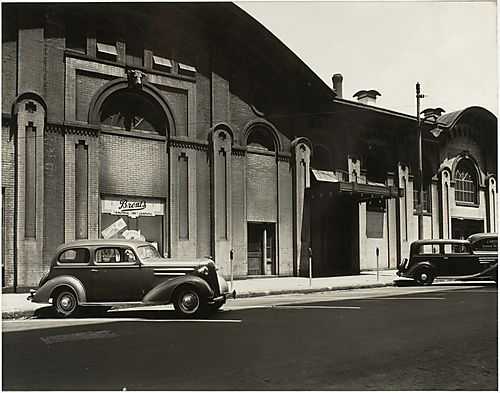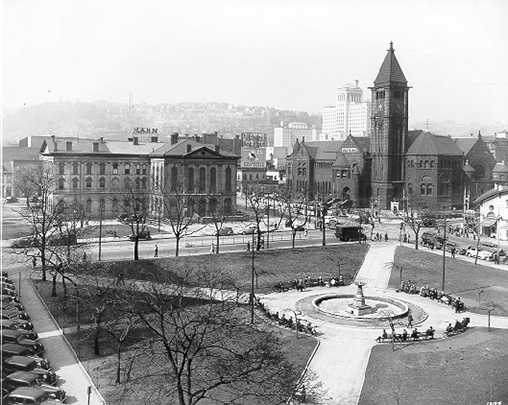Secret Pittsburgh
The Historical Tapestry of Pittsburgh: Northside Then vs. Now
By Anmol Baxi
Allegheny Center is a neighborhood that covers 36 blocks of Pittsburgh’s Northside. The city’s original plan was created by John Redick, who sought to bring together the community of historic Northside back in 1784 (Allegheny Commons). The Center is now home to Buhl Community Park at Allegheny Square, The Buhl Planetarium, Allegheny Commons Municipal Park, The Children’s Museum of Pittsburgh, the National Aviary, and New Hazlett Theater (formerly known as the Carnegie Free Library of Pittsburgh). More recently, Allegheny Center has included high-rise apartment buildings and townhouses. These new centers serve as an entertainment hub for the community, revitalizing the once crumbling Northside.
Allegheny Center is more known for its former mall, Two Allegheny Center, which is now closed down and up for renovation. The once bustling building is now vacant and covered in cardboard windows, begging to be turned into something new and modern. According to The Northside Chronicle, a developer from New York plans to turn the former mall into a technology hub, serving as a “campus for high-tech companies” (Belko). The Northside is also working on making its parks even more environmentally friendly, ensuring endurance over the years to come for the community. Both major parks in Allegheny Center, Buhl Community Park and Allegheny Commons Municipal Park, serve as green getaways from the concrete city of dirty and smoky Pittsburgh. Incorporating green spaces like the parks in the Allegheny Center are proactive steps to evolving an urban society. The creation of these modern centers has been a part of a larger process of restoring the Northside while maintaining its rich historical tapestry.
In 1907, the City of Allegheny was annexed to Pittsburgh and became known as the Northside. The original Town Square of Allegheny County served as a meeting place for legislative members as well as the townspeople. It was not until the late 1800’s that the Northside began demolishing old buildings to replace them with those for recreational purposes. The North Side Market House (see Fig. 3), also called the Allegheny Market House, served as a historical landmark for the North Side in its earliest development. The building was later demolished to make way for the new Allegheny Center. Though the Northside stresses modernization and advancement, it raises the question of satisfaction amongst the people living there. Were these people content with the destruction of old historical buildings to be replaced with new ones? Did they feel as if a piece of their history was being erased rather than renewed? For example, East Liberty is currently undergoing drastic changes to reform its neighborhood and push it into a technologically advanced area. In this case, after the trip to East Liberty, it was evident that the people living there were unhappy with the city’s successful attempts at erasing the town’s rich history. Very few things still serve as markers for the vibrant culture that once flowed through the streets. Is it possible that the Northside, though seen as a “new and beautiful” place to live, is also experiencing the same kind of loss of culture?
An argument that could be used to support the drastically changing Northside could be, that many of the buildings that were knocked down were ones that were abandoned and empty, rather than occupied by people. For example, the Mattress Factory, an art installation museum, was a run down warehouse that was then turned into a place for modern artistic expression. The Mattress Factory is a representation of modernity and change; “since its founding in 1977, the Mattress Factory has been a catalyst for community revitalization in Pittsburgh’s North Side. The museum has rehabilitated properties that were once abandoned or considered non-contributing buildings within the community” (Mattress Factory). The installation of the Factory was an effort to bring together the community and instigate positive change. The museum soon opened an Education Studio for school programs, teacher training, and community activities. The program currently serves more than 20,000 students, teachers, and families annually. The incorporation of modernity seems to be for the better in the North Side as opposed to when we traveled to East Liberty. Though, the same kind of displacement could have occurred in the North Side, it seems that unlike East Liberty, the North Side was deteriorating and needed the modernization in order to sustain its community.
Even after all of the change that the Northside has undergone, I found many stories of former and current residents expressing their fond memories of their pasts through personal narratives. Christina Schmidlapp, a worker for Allegheny Commons, shared a memory of buying her first puppy, and expressing gratitude for the creation of the Park, so that her grandkids may enjoy it the same way she once did. “I remember walking from my house on Cedar Ave. across East Common…Our children remember their time growing up around the Commons with great fondness. I hope when they have their own children, they will be able to take them to the special outdoor place.” (Allegheny Commons). She now works with the Park to continue to encourage its sustainability.
The interweaving of nature and the city is expressed thoroughly in the satirical piece, “How Pittsburgh returned to the Jungle” by Haniel Long. The piece emphasizes the use of imagination to create an environmental space that blankets Pittsburgh’s concrete walls. Long touches the faces “of the skyscrapers” beginning to “turn green” and the “stone valleys where hitherto had sounded only the noise of cars” fill with “bird cries and the humming of tiny insects” (Long). The imagery he uses is what I would like to imagine Pittsburgh to actually be. I feel as though the Northside has successfully begun to connect the urban aspects of the city to the environmental spaces the people crave to create.
I chose to write about the Northside because I wanted to touch on all of the history that exists in places we visit so often, but do not appreciate. It is interesting to see that although there has been change within the community, it still maintains some of its historical aspects through its gothic architecture and rustic landmarks. For example, the fountain located in Buhl Community Park was the original fountain built when that area was known as the Town Square. Yet it is also fascinating to see the stark contrast between the Northside then and now. This is visible especially when comparing old archive photos to current photos (see Fig. 1 and Fig. 2). Of course, the difference in appearance would be expected, as society is always evolving with its people, but physically being able to see the photos side by side is eye opening. It makes me wonder where we will be as a growing society in another decade. After exploring the archive photos, it furthered my interest in the Northside because it seems as though newer residents of Pittsburgh (such as students) do not see the underlying history that exists in the city they live in. Pittsburgh is filled with historically charged cities and neighborhoods. There is so much information to discover, so many new archives to explore, and so many new places to see; The Northside is simply the tip of the iceberg.
Works Cited
Allegheny Commons. N.p., 2003. Web. Accessed 14 Apr. 2017.
Belko, Mark. "Developer Plans to Turn North Side's Allegheny Center into Technology Hub." Pittsburgh Post-Gazette. Pittsburgh Post Gazette, 21 May 2015. Web. Accessed 14 Apr. 2017.
"Children's Museum." Children's Museum of Pittsburgh. N.p., May 2013. Web. Accessed 3 Mar 2017.
"History." Mattress Factory. N.p., n.d. Web. Accessed 3 Mar. 2017.
“Neighborhoods-Northside Market.” Historic Pittsburgh. N.p., Jan 2017. Web. 03. 2017.
Strebig, Neil. "Allegheny Center, a History of Change." Northside Chronicle RSS. N.p., 24 Mar. 2016. Web. Accessed 14 Apr. 2017.
Walsh, Glenn A. "Allegheny Public Square Plaza / Park, North Side, Pittsburgh Formerly Ober Park Now Known As Buhl Community Park at Allegheny Square." Allegheny Public Square - Proposed Rehabilitation. Friends of the Zeiss, Jan. 2008. Web. Accessed 3 Mar. 2017.


